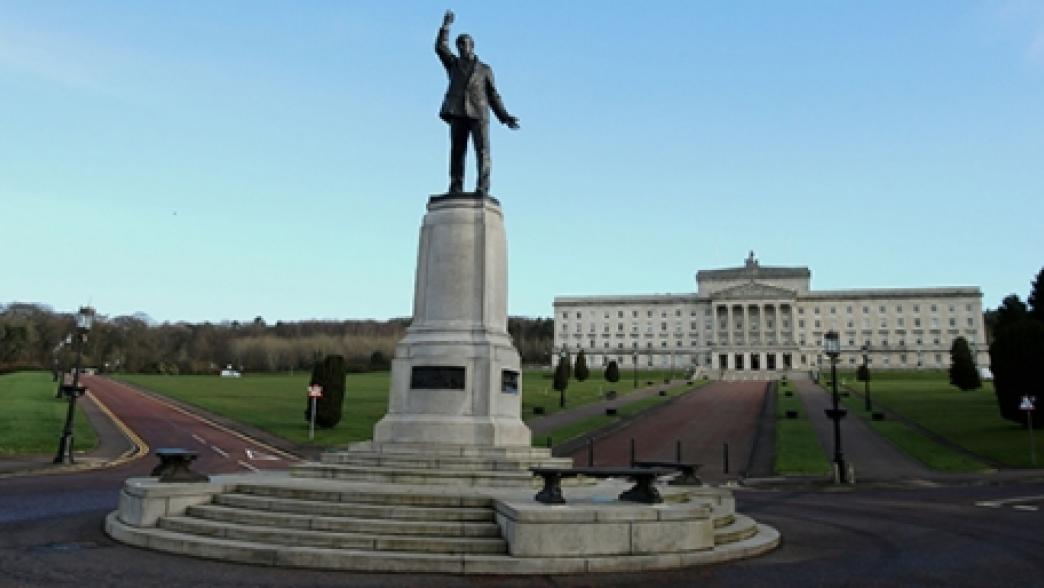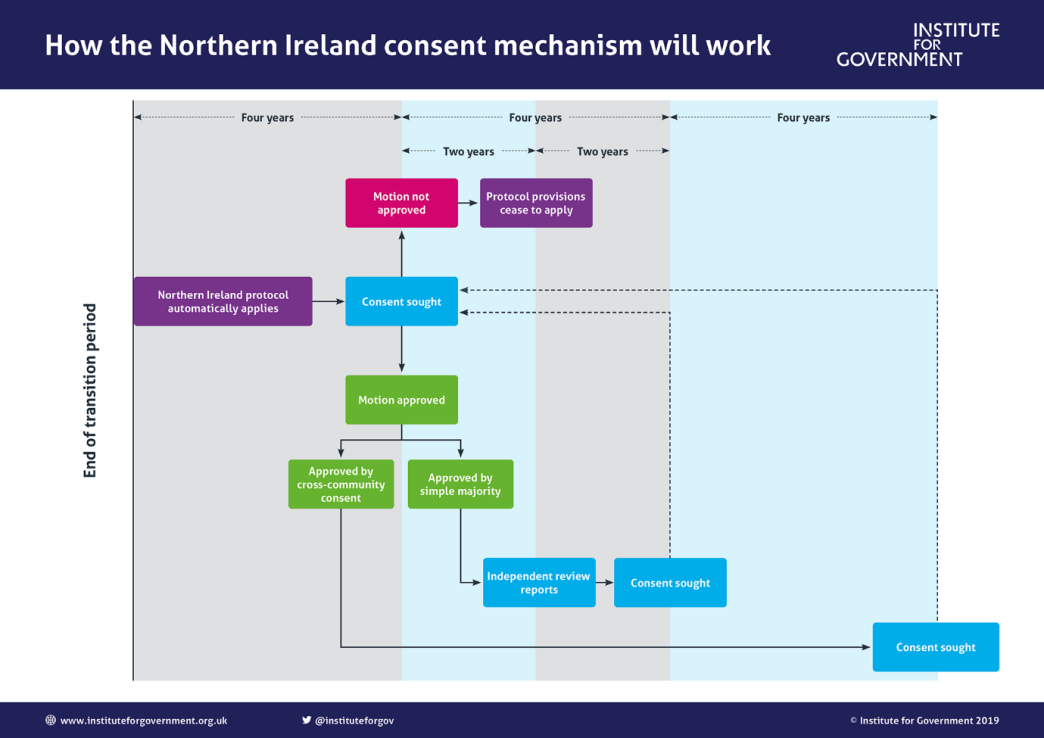Northern Ireland protocol: consent mechanism
The Withdrawal Agreement concluded by the UK government and the EU contains special arrangements for Northern Ireland.

What is the Northern Ireland consent mechanism in the Withdrawal Agreement?
The Withdrawal Agreement concluded by the UK government and the EU contains special arrangements for Northern Ireland. The Northern Ireland protocol aims to avoid a hard border on the island of Ireland.
Northern Ireland will remain aligned to EU regulations in areas needed to avoid a hard border, such as ‘industrial goods’ and agri-food. Northern Ireland will also apply EU VAT and customs rules, although it will remain in the UK’s customs territory. As a result, checks and paperwork are required on goods moving between Great Britain and Northern Ireland, and tariffs are payable on goods that cannot be certified as staying in Northern Ireland.
Under the terms of the Withdrawal Agreement, the Northern Ireland institutions will be periodically asked to consent to the trading arrangements in articles 5–10 of the protocol for as long as they are in place. It would give the institutions an opportunity to vote on whether to remain in the arrangements or choose to exit from them. The first consent vote is due to take place in December 2024.
The other articles of the protocol which include guarantees to rights and equality, a commitment to the common travel area and to maintain north–south co-operation will remain in force regardless of any consent vote.
How will the consent mechanism work?
The provisions of the Northern Ireland protocol automatically entered into force at 11pm on 31 December 2020, at the end of the Brexit transition period. After four years, the UK must provide Northern Ireland with the opportunity to decide whether or not those provisions remain in place.
The Withdrawal Agreement itself doesn’t state how Northern Ireland should give consent – it states that is for the UK to determine how that decision is made. The UK government set out a process for the consent mechanism in a unilateral declaration, 22 Declaration by Her Majesty’s Government of the United Kingdom of Great Britain and Northern Ireland concerning the operation of the ‘Democratic consent in Northern Ireland’ provision of the Protocol on Ireland/Northern Ireland, assets.publishing.service.gov.uk/government/uploads/system/uploads/attachment_data/file/840232/Unilateral_Declaration_on_Consent.pd which it legislated for through the Protocol on Ireland/Northern Ireland (Democratic Consent Process) (EU Exit) Regulations 2020, 23 The Protocol on Ireland/Northern Ireland (Democratic Consent Process) (EU Exit) Regulations 2020, www.legislation.gov.uk/uksi/2020/1500/contents/made which came into force in December 2020.
Consent can be given if a simple majority of the Northern Ireland assembly (MLAs) vote in favour. This is unlike usual practice in the assembly, where decisions are normally subject to a mechanism called the petition of concern. This may be brought by 30 MLAs and requires the decision to obtain cross-community consent (with a specified proportion of unionists and nationals MLAs) to pass. UK ministers said that as the vote is on a matter which is usually in the competence of the UK government, not a devolved matter, normal assembly procedures will not apply, 24 Hansard, Draft Protocol on Ireland/Northern Ireland (Democratic Consent Process) (EU Exit) Regulations 2020, 26 November 2020, hansard.parliament.uk/Commons/2020-11-26/debates/82384cf5-23b5-43a4-a1c4-5036a3c687b1/DraftProtocolOnIrelandNorthernIreland(DemocraticConsentProcess)(EUExit)Regulations2020 and the regulations state that the petition of concern does not apply to the consent motion.
The consent motion should be proposed jointly by the first minister (FM) and the deputy first minister (DFM), and should be considered in the executive committee (the equivalent of the UK cabinet). However, if the FM/DFM fail agree on the wording of the motion within one month, another member of the Northern Ireland assembly can table the motion instead.
What happens if consent is given?
If consent is given, the protocol will continue to apply.
If the vote passes by a simple majority, consent will need to be sought again four years later. The UK government will also be required to commission an independent review into the functioning of the Northern Ireland protocol and the implications of its implementation or termination. The review must report within four years.
If the vote passes with cross community consent, then consent will only need to be sought again after eight years. A vote is classified as having cross community consent if either:
- A majority of total MLAs and a majority of both nationalist and unionists in attendance, vote in favour; or
- 60% of MLAs, including 40% of unionists and nationalists in attendance, vote in favour.
Consent will continue to be sought periodically for as long as the protocol remains in force.

What happens if consent is not given?
If consent is not given, the protocol will cease to apply after two years.
In this case, the Joint Committee established under the Withdrawal Agreement to oversee the protocol will make recommendations to the UK and the EU on alternatives for avoiding a hard border and protecting the Good Friday Agreement. What options are available will depend on the nature of any EU-UK trade agreement in place at the time.
What if there is no government in Northern Ireland?
The Northern Ireland institutions did not function between January 2017 and January 2020. The UK government did not impose direct rule to allow UK ministers to govern Northern Ireland directly, so although devolution remained in tact there were no ministers in position, and the Northern Ireland assembly did not sit.
If the executive is not functioning at the point when the UK government is required to seek consent from the Northern Ireland institutions, an alternative consent process is in place. Any member of the Northern Ireland assembly may table the consent motion, and the presiding officer is required to recall the Assembly. If the assembly needs to elect a new presiding officer, they may do so by a simple majority (in normal circumstances cross-community consent is required).
However, it is not clear how consent will be sought if direct rule is imposed, devolution is suspended and the assembly has been dissolved.
The Withdrawal Agreement states that the protocol will cease to apply if consent is sought, a decision is reached, and the UK notifies the EU that the decision is not in favour of continued application of the protocol. This suggests that if consent is never sought and a decision is never made because the institutions aren’t functional, the default is that the protocol will continue to apply.
Why did the EU 27 accept a consent mechanism when they had rejected any “unilateral exit” under Theresa May?
The consent mechanism creates the possibility that Northern Ireland could leave the trading arrangements set out in the protocol at some point in the future, even with the potential that such a decision could result in a hard border.
The EU had previously rejected attempts by the UK to include a ‘unilateral exit mechanism’ for the backstop. But there were a number of significant factors that led to it accepting the consent mechanism.
First, the Northern Ireland arrangements no longer include UK-wide elements. Under Theresa May’s deal, asking the Northern Ireland institutions to vote on the application of a UK wide customs union was not considered possible. But by reverting to something that is Northern Ireland only, it was possible to put in an exit mechanism that was focused on democratic consent.
The EU and Ireland also feel that, if the decision was in the hands of Northern Ireland alone and not the UK Parliament, the risk of a vote against the arrangements is reduced. There is a wide-spread opposition to no-deal in Northern Ireland. In August, over half of MLAs signed a letter 25 Devenport M, MLA appeal over backstop in letter to Tusk, BBC News, 22 August 2019, www.bbc.co.uk/news/uk-northern-ireland-49435880 to the EU Council President expressing their support for Theresa May’s backstop.
What was the reaction been in Northern Ireland?
The consent mechanism has received a mixed reaction from political parties in Northern Ireland. Northern Ireland’s largest Unionist Party the DUP have argued that the mechanism violates the principle of consent in the Good Friday Agreement, as the vote could be passed by a simple majority, without the support of both communities. Several Unionist parties and UK politicians have launched a legal challenge to the consent mechanism regulations and the protocol itself on this basis. 26 McBride S, Unionist leaders unite to go to court over Irish Sea border, arguing it breaches the 1800 Act of Union and 1998 Belfast Agreement, News letter, 21 February 2021, www.newsletter.co.uk/news/politics/unionist-leaders-unite-to-go-to-court-over-irish-sea-border-arguing-it-breaches-the-1800-act-of-union-and-1998-bel…
Mary Lou McDonald, the leader of Sinn Fein, the largest nationalist party, strongly refuted 27 Cordon G, Future of Stormont in doubt over veto, DUP and SF both warn, Belfast Telegraph, 22 October 2019, www.belfasttelegraph.co.uk/news/northern-ireland/future-of-stormont-in-doubt-over-veto-dup-and-sf-both-warn-38618195.html the DUP’s argument, claiming that a requirement for a cross-community vote would effectively give the DUP a veto, and warned that if the mechanism were changed “there will be no assembly here in Belfast”.
Leader of the cross-community Alliance Party, Naomi Long, expressed similar concerns 28 Alliance Party of Northern Ireland, 'Johnson's deal creates Brexiternity for Northern Ireland' – Naomi Long, 18 October 2019, www.facebook.com/watch/?v=523344654880286 about a rolling ‘Brexeternity’ which create uncertainty for Northern Ireland business and hamper their ability to plan in the long-term.
- Topic
- Brexit Devolution
- Keywords
- Northern Ireland protocol
- Public figures
- Theresa May
- Publisher
- Institute for Government